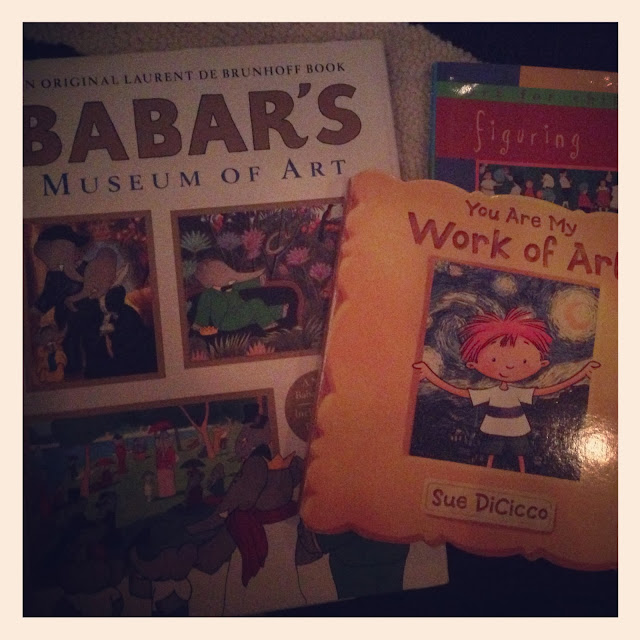 |
| A few of the "art" books in our library: Babar's Museum of Art by Laurent de Brunhoff; You are My Work of Art by Sue Dicicco; and Art for Children, Figuring Figures by Brigitte Baumbusch. |
Having a very creative and inquisitive three year old, I am
always looking for ways to aid her in discovery and awareness of the things
that excite her. Through this process, I am also passing on my own loves and
interests. One of those loves is art and art history. On any given day, we have
multiple art “activities” (as she likes to refer to any project we have going)
in the works, hanging to dry, and on display in her “gallery” or “studio” (two
different places in our home). Art is very much a part of our everyday
vocabulary. We explore in doors and out of doors, talking about the things we
see, looking at little details, comparing and contrasting, collecting, etc. The
lesson plans I have selected all focus on teaching art elements and history
through a collection of art historical masterpieces. By using these
masterpieces to teach color, line, shape, texture, and subject, I am also able
to teach culture, context, visual thinking skills, and history (just to name a
few). The primary target age are preschoolers. It is my hope to use these with my daughter.
1. COLOR! This lesson explores the very
basics of color: the science of color, primary colors (Modrian), secondary
colors (Seurat and pointillism); as well as the emotional impacts of color
(Matisse) and colors found in nature (Monet). Each lesson incorporates the
works of art by the artist and hands own exploration of his technique.
2. Art Cave Drawings (Learning Center) This learning center offers children an opportunity to learn about art forms from prehistoric cultures and experiment with a variety of materials by creating their own “cave art.”
3. Elements of Art These are a series of lessons that explore color, line, shape, texture, and space in various museum setting (but are easily adapted to the classroom).
4. Animals in Art By focusing on the subject matter in a grouping similar of masterpieces (all have tigers found within the painting), this lesson encourages students to compare and contrast as well as relate the paintings to their own personal experiences. Featured artists include Jean-Leon Gerome and Eugene Delacroix)
5. Animals in Art II This lesson is based on the same idea as the one above. However, it introduces light and dark contrasts and the concept of space (above, below, behind, etc). Paul Gauguin is the artist highlighted in this lesson.
6. Line Manipulatives This hands-on activity used the works of Van Gogh, Miro, and Mark Tobey to explore lines in artwork.
7. Straight Lines Explores the element of lines through the artwork of Kandinsky, Modrian, Picasso, and Stella. Activities and artists in this lesson vary from those in the lesson above.
2. Art Cave Drawings (Learning Center) This learning center offers children an opportunity to learn about art forms from prehistoric cultures and experiment with a variety of materials by creating their own “cave art.”
3. Elements of Art These are a series of lessons that explore color, line, shape, texture, and space in various museum setting (but are easily adapted to the classroom).
4. Animals in Art By focusing on the subject matter in a grouping similar of masterpieces (all have tigers found within the painting), this lesson encourages students to compare and contrast as well as relate the paintings to their own personal experiences. Featured artists include Jean-Leon Gerome and Eugene Delacroix)
5. Animals in Art II This lesson is based on the same idea as the one above. However, it introduces light and dark contrasts and the concept of space (above, below, behind, etc). Paul Gauguin is the artist highlighted in this lesson.
6. Line Manipulatives This hands-on activity used the works of Van Gogh, Miro, and Mark Tobey to explore lines in artwork.
7. Straight Lines Explores the element of lines through the artwork of Kandinsky, Modrian, Picasso, and Stella. Activities and artists in this lesson vary from those in the lesson above.
8. Shapes in Art Using a variety of objects (tanagrams, vegetables, etc.) students explore, discover, and recreate shapes in the art of Paul Klee.
9. Songs in the Key of Art This lesson incorporates music to reinforce teaching and understanding of the elements of art. Students listen to Greg Percy's "Songs in the Key of Art" while exploring the works of Kandinsky, Matisse, Modrian, and Denise Pannell (just to name a few). The lesson links to many more songs featuring topics of art and art history.
10. Smelly Fruit Very simply, this lesson connects the senses using scented markers that students use to create still lifes with the corresponding fruit. While creating a kind of “scratch and sniff” art work is fun and appealing, I would suggest using old master's still life paintings (Severin Roesen, Pieter Claesz, Caravaggio) to inspire the students own creations.
Each of these lessons can be easily adapted to any age
group. All include exciting hands-on learning that encourages the importance of
creation. For my preschooler, the things made by her hands are extremely
valuable and often seen as an extension of herself. By using art history to
teach the elements of art to my three-year old, I am able to reinforce the value
of her art as well as introduce her to a world of artists and masterpieces that
influence us still today.
 |
| Tilda's Gallery |
 |
| Tilda's Studio (these are old pictures, these paintings have already been "sold" and replaced many times over :) |
No comments:
Post a Comment